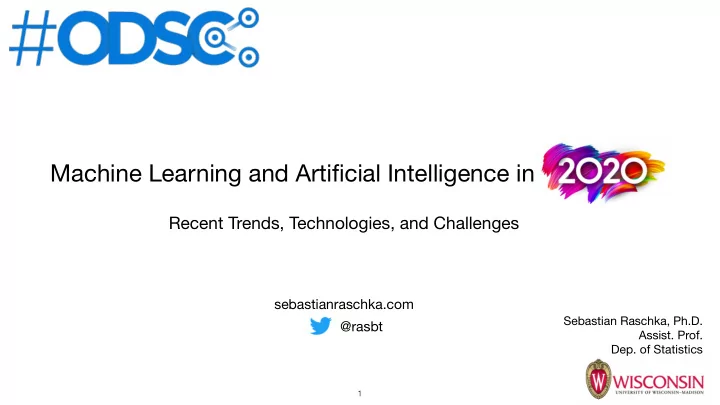

Machine Learning and Artificial Intelligence in Recent Trends, Technologies, and Challenges sebastianraschka.com Sebastian Raschka, Ph.D. @rasbt Assist. Prof. Dep. of Statistics 1
information Article Machine Learning in Python: Main Developments and Technology Trends in Data Science, Machine Learning, and Artificial Intelligence Sebastian Raschka 1, * ,† , Joshua Patterson 2 and Corey Nolet 2,3 1 Department of Statistics, University of Wisconsin-Madison, Madison, WI 53575, USA 2 NVIDIA, Santa Clara, CA 95051, USA; joshuap@nvidia.com (J.P.); cnolet@nvidia.com (C.N.) 3 Department of Comp Sci & Electrical Engineering, University of Maryland, Baltimore County, Baltimore, MD 21250, USA * Correspondence: sraschka@wisc.edu † Current address: 1300 University Ave, Medical Sciences Building, Madison, WI 53706, USA. ��������� � ������� Received: 6 February 2020; Accepted: 31 March 2020; Published: 4 April 2020 See “Machine Learning with Python,” a special issue of Information (ISSN 2078-2489) https://www.mdpi.com/journal/information/special_issues/ML_Python 2
Part 1: Technologies and Tools 3
https://cse.engin.umich.edu/about/history/ https://careers.google.com/locations/pittsburgh/ 4
Python for-loops are bad z = ∑ x i w i + b i 5
Python for-loops are bad: Use SIMD & vectorized code whenever you can z = ∑ x i w i + b i = x ⊤ w 6
For-loops vs. Vectorized Code Dot product is approx.1500x faster 7
Can we speed this up further using GPUs? GPU is approx. 3x slower 8
Can we speed this up further using GPUs? (Yes, if the data / computation is large) GPU is approx. 230x faster 9
Data Preparation Model Training Visualization Dask Pandas Scikit-Learn Network-X PyTorch Chainer MxNet Matplotlib Seaborn Analytics Machine Learning Graph Analytics Deep Learning Visualization GPU Memory CPU Memory Figure 1. The standard Python ecosystem for machine learning, data science, and scientific computing. Sebastian Raschka, Joshua Patterson, and Corey Nolet (2020) Machine Learning in Python: Main developments and technology trends in data science, machine learning, and artificial intelligence Information 2020, 11, 193 10
Data Preparation Model Training Visualization Dask cuDF cuIO cuML cuGraph PyTorch Chainer MxNet cuXfilter <> pyViz Analytics Machine Learning Graph Analytics Deep Learning Visualization GPU Memory Figure 4. RAPIDS is an open source effort to support and grow the ecosystem of GPU-accelerated Python tools for data science, machine learning, and scientific computing. RAPIDS supports existing libraries, fills gaps by providing open source libraries with crucial components that are missing from the Python community, and promotes cohesion across the ecosystem by supporting interoperability across the libraries. Sebastian Raschka, Joshua Patterson, and Corey Nolet (2020) Machine Learning in Python: Main developments and technology trends in data science, machine learning, and artificial intelligence Information 2020, 11, 193 11
����������������������� ��� ��������������������������������������������������� GPUs Sebastian Raschka. Python ������������������������������������������ Machine Learning. ��������������������������������������������������������������������������������� Birmingham, UK: Packt Publishing, 2015 ����������������������������������������������������������������������� ���������������������������������������������������������������������������������� https://www.theverge.com/2015/5/31/8695075/nvidia-geforce-gtx-980-ti-announced Sebastian Raschka and Vahid �� Mirjalili. Python Machine Learning 2nd Ed. �� Birmingham, UK: Packt Publishing, 2017 Image: https://www.amazon.com/Nvidia-GEFORCE-GTX-1080-Ti/dp/B06XH5ZCLP ���������������������������������������������������������������������������������� Sebastian Raschka and Vahid Mirjalili. Python Machine Learning 3rd Ed. Birmingham, UK: Packt Publishing, 2019 Image: https://www.nvidia.com/en-in/geforce/graphics-cards/rtx-2080-ti/ 12 ��������������������������������������������������������������������������������� ��������������������������������������������������������������������������������������� ����� �����
~$1,100; 11 Gb Memory ~$8,000; 16 Gb Memory Source: https://lambdalabs.com/blog/2080-ti-deep-learning-benchmarks/ 13
Developing Specialized Hardware https://arstechnica.com/gadgets/2018/07/the-ai-revolution-has-spawned-a-new-chips-arms-race/ https://www.marketwatch.com/story/new-nvidia-chip-extends-the-companys-lead-in- graphics-artificial-intelligence-2018-08-14 https://www.reuters.com/article/us-amazon-com-nvidia/amazon-launches-machine-learning-chip- https://developer.arm.com/products/processors/machine-learning/arm-ml-processor 14 taking-on-nvidia-intel-idUSKCN1NX2PY
Deep Learning frameworks The new "Emacs vs VIM" Which DL framework is most popular? 15
https://thegradient.pub/state-of-ml-frameworks-2019-pytorch-dominates-research- tensorflow-dominates-industry/ 16
https://thegradient.pub/state-of-ml-frameworks-2019-pytorch-dominates-research- tensorflow-dominates-industry/ This graph was generated by scraping every paper published in a major ML conference over the last few years. Papers were categorized based on whether they mention PyTorch or TensorFlow, excluding papers with authors affiliated with either Google or Facebook, as well as those that mention both TensorFlow and PyTorch 17
"Most I've spoken to (and I'm from a background in ML academia); PyTorch is by a very slim margin faster than TensorFlow 2.0 in our experiences when you run TensorFlow in non-Eager mode. However, since Eager mode is now enabled by default in TensorFlow 2.0; PyTorch is significantly faster." https://www.reddit.com/r/MachineLearning/comments/f19dj4/d_tensorflow_20_v_pytorch_performance_question/ 18
Source: https://medium.com/huggingface/benchmarking-transformers-pytorch-and-tensorflow-e2917fb891c2 19
a b In: In In In: Defining g the gr graph Initializing g and evaluating g the gr graph Out: Out: Out: Out: Figure 7. Comparison between ( a ) a static computation graph in TensorFlow 1.15 and ( b ) an imperative programming paradigm enabled by dynamic graphs in PyTorch 1.4. Sebastian Raschka, Joshua Patterson, and Corey Nolet (2020) Machine Learning in Python: Main developments and technology trends in data science, machine learning, and artificial intelligence Information 2020, 11, 193 20
DL Frameworks are converging Two ways for turning a PyTorch model into a static graph for optimization and "intermediate" representation (IR) deployment: <=> "static graph" a) Tracing b) Scripting Image Source: https://thegradient.pub/state-of-ml- frameworks-2019-pytorch-dominates-research- tensorflow-dominates-industry/ 21
DL Frameworks are converging 22
"Hot" research areas Challenges Technologies 23
Challenges: Adding forward-mode autodiff for efficient higher-order derivatives (e.g., Hessians) 24
JAX Composable transformations of Python+NumPy programs: di ff erentiate, vectorize, JIT to GPU/TPU, and more Forward mode AD for PyTorch: https:// github.com/pytorch/pytorch/issues/10223 Swift 25
Challenges: Adversarial attacks 26
Recommend
More recommend